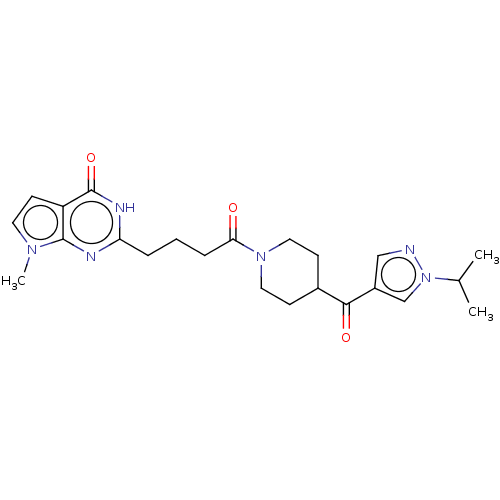BDBM50169058 CHEMBL3806049
SMILES CC(C)n1cc(cn1)C(=O)C1CCN(CC1)C(=O)CCCc1nc2n(C)ccc2c(=O)[nH]1
InChI Key InChIKey=LMUIMYHRSNNJLB-UHFFFAOYSA-N
Activity Spreadsheet -- Enzyme Inhibition Constant Data from BindingDB
 Found 4 hits for monomerid = 50169058
Found 4 hits for monomerid = 50169058
TargetPoly [ADP-ribose] polymerase tankyrase-2(Homo sapiens (Human))
Therachem Research Medilab (India)
Curated by ChEMBL
Therachem Research Medilab (India)
Curated by ChEMBL
Affinity DataIC50: 0.280nMAssay Description:Inhibition of GST-tagged TNKS2 (873 to 1166 residues) (unknown origin) autoparsylation using biotinylated NAD incubated for 1 hr by ELISAMore data for this Ligand-Target Pair
TargetPoly [ADP-ribose] polymerase tankyrase-1/tankyrase-2(Homo sapiens (Human))
Therachem Research Medilab (India)
Curated by ChEMBL
Therachem Research Medilab (India)
Curated by ChEMBL
Affinity DataEC50: 21nMAssay Description:Inhibition of tankyrase in human DLD1 cells assessed as increase in axin2 level after 24 hrs by fluorescence analysisMore data for this Ligand-Target Pair
TargetPoly [ADP-ribose] polymerase 1(Homo sapiens (Human))
Therachem Research Medilab (India)
Curated by ChEMBL
Therachem Research Medilab (India)
Curated by ChEMBL
Affinity DataIC50: 1.80E+3nMAssay Description:Inhibition of human recombinant His-tagged PARP1 autoparsylation expressed in sf21 cells using NAD and biotinylated NAD incubated for 150 mins by HTR...More data for this Ligand-Target Pair
TargetPoly [ADP-ribose] polymerase tankyrase-1(Homo sapiens (Human))
Therachem Research Medilab (India)
Curated by ChEMBL
Therachem Research Medilab (India)
Curated by ChEMBL
Affinity DataIC50: 0.810nMAssay Description:Inhibition of GST-tagged TNKS1 (1023 to 1327 residues) (unknown origin) autoparsylation using biotinylated NAD incubated for 1 hr by ELISAMore data for this Ligand-Target Pair
